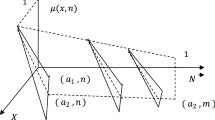Abstract
As the industrial environment becomes more competitive, supply chain management (SCM) has become essential. Especially in the case of deteriorating products, demand is an imprecise parameter and leads to uncertainty in other parameters like holding cost and total cost. The objective of the current study is to manage procurement & distribution coordination, who faces many barriers because of the imprecise behaviour of the parameters discussed above while calculating economic order quantity (EOQ), which moves from one source to an intermediate stoppage (Stage I) and further to final destination (Stage II) incorporating quantity and freight discounts at the time of transporting goods in stage I and using truckload (TL) and less than truckload (LTL) policy in stage II. Finding solutions for such class of coordination is highly complex. To reduce the complexity and to find the optimal solution, differential evolution approach is used. The model is validated with the help of a case problem.
Access this chapter
Tax calculation will be finalised at checkout
Purchases are for personal use only
Preview
Unable to display preview. Download preview PDF.
Similar content being viewed by others
References
Roy, A. Kar, S., Maiti, M.: A deteriorating multi-item inventory model with fuzzy costs and resources based on two different defuzzification techniques. Applied Mathematical Modelling. 32, 208-223 (2008).
Minner, S.: Multiple-supplier inventory models in SCM: A review. International Journal of Production Economics. 81/82, 265-279 (2003).
Ranjan, B., Susmita, B.: A review of the causes of bullwhip effect in a supply chain. The International Journal of Advanced Manufacturing Technology. 54, 1245-1261(2011).
Alamri, A. A., Balkhi, Z. T.: The effects of learning and forgetting on the optimal production lot size for deteriorating items with time varying demand and deterioraion rates. International Journal of Production Economics. 107, 125-138 (2007).
Hsu, P. H., Wee, H. M., Teng, H. M.: Preservation technology investment for deteriorating inventory. International Journal of Production Economics. 124, 388-394 (2010).
Misra, R.B.: Optimum production lot-size model for a system with deteriorating inventory. Int. J. Prod. Res. 13, 495–505 (1975).
Goyal, S.K., Gunasekaran, A.: An integrated production inventory marketing model for deteriorating item. Comput. Ind. Eng. 28, 755–762 (1995).
Benkherouf, L.A.: Deterministic order level inventory model for deteriorating items with two storage facilities. Int. J. Prod. Economics. 48, 167–175 (1997).
Giri, B.C., Chaudhuri, K. S.: Deterministic models of perishable inventory with stock dependent demand rate and non-linear holding cost. Euro. J. Oper. Res. 19, 1267–1274 (1998).
Goyel, S.K., Giri, B.C.: Recent trends in modeling of deteriorating inventory. Euro. J. Oper. Res. 134, 1–16 (2001).
Tu, H.H.J., Lo, M.C., & Yang, M.F.: A two-echelon inventory model for fuzzy demand with mutual beneficial pricing approach in a supply chain. African Journal of Business Management. 5(14), 5500-5508 (2011).
Xu, R., Zhai, X.: Optimal models for single-period supply chain problems with fuzzy demand. Information Sciences. 178(17), 3374–3381 (2008).
Price, K.V., Storn, R.M.: Differential Evolution-A simple and efficient adaptive scheme for global optimization over continuous space (Tech. Rep. No. TR-95-012). ICSI. Available via the Internet: ftp.icsi.berkeley.edu/pub/techreports/1995/tr-95-012.ps.Z. (1995).
Price, K.V.: An introduction to Differential Evolution. In: Corne, D., Marco, D. & Glover, F. (Eds.), New Ideas in Optimization. London, UK: McGraw-Hill. 78-108 (1999).
Zimmermann, H.J.: Description and optimization of fuzzy systems. International Journal of General Systems. 2, 209–215 (1976).
Author information
Authors and Affiliations
Corresponding author
Editor information
Editors and Affiliations
Rights and permissions
Copyright information
© 2013 Springer India
About this paper
Cite this paper
Gandhi, K., Jha, P.C., Ali, S.S. (2013). A Two Stage EOQ Model for Deteriorating Products Incorporating Quantity & Freight Discounts, Under Fuzzy Environment. In: Bansal, J., Singh, P., Deep, K., Pant, M., Nagar, A. (eds) Proceedings of Seventh International Conference on Bio-Inspired Computing: Theories and Applications (BIC-TA 2012). Advances in Intelligent Systems and Computing, vol 202. Springer, India. https://doi.org/10.1007/978-81-322-1041-2_32
Download citation
DOI: https://doi.org/10.1007/978-81-322-1041-2_32
Published:
Publisher Name: Springer, India
Print ISBN: 978-81-322-1040-5
Online ISBN: 978-81-322-1041-2
eBook Packages: EngineeringEngineering (R0)




